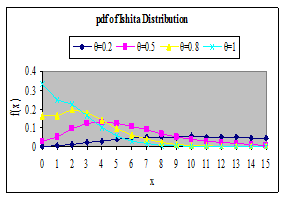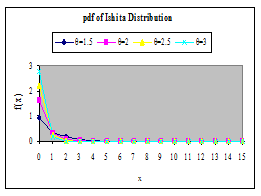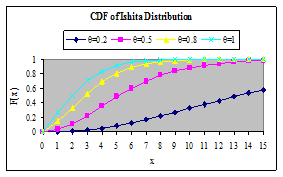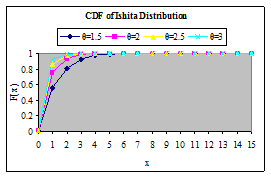Abstract
In the present paper, a lifetime distribution named, “Ishita distribution” for modeling lifetime data from biomedical science and engineering has been proposed. Statistical properties of the distribution including its shape, moments, skewness, kurtosis, hazard rate function, mean residual life function, stochastic ordering, mean deviations, order statistics, Bonferroni and Lorenz curves, Renyi entropy measure, stress-strength reliability have been discussed. The condition under which Ishita distribution is over-dispersed, equi-dispersed, and under-dispersed are presented along with the conditions under which Akash distribution, introduced by Shanker,1 Lindley distribution, introduced by Lindley2 and exponential distribution are over-dispersed, equi-dispersed and under-dispersed. Method of maximum likelihood estimation and method of moments have been discussed for estimating the parameter of the proposed distribution. Finally, the goodness of fit of the proposed distribution have been discussed and illustrated with two real lifetime data sets and the fit has been compared with exponential, Lindley and Akash distributions.
Keywords: akash distribution, lindley distribution, moments, dispersion, hazard rate function, mean residual life function, mean deviations, order statistics, stressstrength reliability, estimation of parameter, goodness of fit
Introduction
The analyzing and modeling real lifetime data are crucial in many applied sciences including medicine, engineering, insurance and finance, amongst others. The two important one parameter lifetime distributions namely exponential and Lindley2 are popular for modeling lifetime data from biomedical science and engineering. Recently, Shanker et al.3 have conducted a comparative and critical study on the modeling of lifetime data from biomedical science and engineering using exponential and Lindley distributions and observed that there are many lifetime data where these two distributions are not suitable due to their shapes, nature of hazard rate functions, and mean residual life, amongst others. While searching a lifetime distribution which gives better fit than exponential and Lindley, Shanker1 has introduced a lifetime distribution named Akash distribution and showed that Akash distribution gives much better fit than both exponential and Lindley distributions. Shanker et al.4 have comparative study on the modeling of lifetime data using Akash, Lindley and exponential distribution and observed that there are several situations where these lifetime distributions are not suitable either from theoretical or applied point of view. Therefore, an attempt has been made in this paper to obtain a new lifetime distribution which is flexible than Akash, Lindley and exponential distributions for modeling lifetime data in reliability and in terms of its hazard rate shapes. The new one parameter lifetime distribution is based on a two- component mixture of an exponential distribution having scale parameter
and a gamma distribution having shape parameter 3 and scale parameter
with their mixing proportion
.
Lindley distribution, introduced by Lindley2 has been defined by the probability density function (p.d.f.) and the cumulative distribution function (c.d.f.) as
(1.1)
(1.2)
It can be easily verified that the density (1.1) is a two-component mixture of an exponential
distribution and a gamma
with their mixing proportion
. Recent years much works have been done on Lindley distribution , its generalization and mixture with other distributions by several authors including Ghitany et al ,5 Zakerzadeh and Dolati,6 Mazucheli and Achcar,7 Bakouch et al,8 Shanker and Mishra9,10 Shanker et al,11 Shanker and Amanuel,12 Sankaran,13 are some among others.
Akash distribution, introduced by Shanker1 has been defined by the probability density function (p.d.f.) and the cumulative distribution function (c.d.f.) as
(1.3)
(1.4)
It can be easily verified that the Akash distribution is a two-component mixture of exponential
distribution and a gamma
distribution with mixing proportion
. Shanker14 has obtained a Poisson mixture of Akash distribution named, “Poisson-Akash distribution (PAD) and discussed its properties, estimation of parameter and applications. Shanker et al.15 have detailed study on modeling of count data from different fields of knowledge using Poisson-Akash distribution. Shanker and Shukla16 have obtained weighted Akash distribution and studied its statistical and mathematical properties, estimation of parameters and applications to model lifetime data. Shanker17 has also obtained a quasi Akash distribution, studied its mathematical and statistical properties, estimation of parameters using both maximum likelihood estimation and method of moments and applications to model lifetime data.
The new one parameter lifetime distribution has been defined by its probability density function (p.d.f.)
(1.5)
We would name this probability density function as, “Ishita distribution”. It can be easily verified that the Ishita distribution is a two-component mixture of exponential
distribution and a gamma
distribution with mixing proportion
.
The corresponding cumulative distribution function (c.d.f.) of (1.5) can be obtained as
(1.6)
The graph of the p.d.f. and the c.d.f. of Ishita distribution for varying values of the parameter
are shown in figures 1 and 2.


Figure 1 Graph of the pdf of Ishita distribution for varying values of the parameter
.


Figure 2 Graph of the cdf of Ishita distribution for varying values of the parameter
.
Statistical constants
The moment generating function of Ishita distribution (1.5) can be obtained as
The
th moment about origin of Ishita distributon (1.5) is given by
(2.1)
The first four moments about origin are thus obtained as
,
,
Using relationship between moments about mean and the moments about origin, the moments about mean of Ishita distribution (1.5) can be obtained as
The coefficient of variation
, coefficient of skewness
, coefficient of kurtosis
and index of dispersion
of Ishita distribution (1.5) are thus obtained as
The over-dispersion, equi-dispersion, and under-dispersion of Ishita distribution has been presented in table 1 along with Akash, Lindley and exponential distributions.
Lifetime Distributions |
Over-Dispersion
|
Equi-Dispersion
|
Under-Dispersion
|
Ishita |
|
|
|
Akash |
|
|
|
Lindley |
|
|
|
Exponential |
|
|
|
Table 1 Over-dispersion, equi-dispersion and under-dispersion of Ishita, Akash, Lindley and exponential distributions for the parameter
Hazard rate function and mean residual life function
Let
be a continuous random variable with p.d.f.
and c.d.f.
. The hazard rate function (also known as the failure rate function)
and the mean residual life function
of
are respectively defined as
(3.1)
and
(3.2)
The corresponding hazard rate function,
and the mean residual life function,
of the Ishita distribution (1.5) are thus obtained as
(3.3)
and
(3.4)
It can be easily verified that
and
.It is also obvious from the graphs of
and
that
is an increasing function of
and
and decreasing function for
and
and for
and decreasing function for
, where as
is a decreasing function of
and
.
. The graph of the hazard rate function and mean residual life function of Ishita distribution (1.5) are shown in figures 3&4.
Figure 3 Graph of hazard rate function of Ishita distribution for varying values of parameter
.
Figure 4 Graph of mean residual life function of Ishita distribution for varying values of parameter
.
Stochastic orderings
Stochastic ordering of positive continuous random variables is an important tool for judging their comparative behavior. A random variable
is said to be smaller than a random variable
in the
- Stochastic order
if
for all
- Hazard rate order
if
for all
- Mean residual life order
if
for all
- Likelihood ratio order
if
decreases in
.
The following results due to Shaked and Shanthikumar18 are well known for establishing stochastic ordering of distributions
(4.1)
The Ishita distribution is ordered with respect to the strongest ‘likelihood ratio’ ordering as shown in the following theorem:
Theorem
Let
Ishita distributon
and
Ishita distribution
. If
, then
and hence
,
and
.
Proof
We have
Now
This gives
Thus for
,
. This means that
and hence
,
and
.
Mean deviations
Generally the amount of scatter in a population is measured to some extent by the totality of deviations usually from their mean and median. These are known as the mean deviation about the mean and the mean deviation about the median defined as
and
, respectively, where
and
. The measures
and
can be calculated using the following relationships
(5.1)
and
(5.2)
Using p.d.f. (1.5) and expression for the mean of Ishita distribution, we get
(5.3)
(5.4)
Using expressions from (3.1), (3.2), (3.3), and (3.4), the mean deviation about mean,
and the mean deviation about median,
of Ishita distribution are obtained as
(5.5)
(5.6)
Order statistics
Let
be a random sample of size
from Ishita distribution (3.5). Let
denote the corresponding order statistics. The p.d.f. and the c.d.f. of the
th order statistic, say
are given by
and
,
respectively, for
.
Thus, the p.d.f. and the c.d.f of
th order statistic of Ishita distribution (3.5) are given by
and
Bonferroni and lorenz curves
The Bonferroni and Lorenz curves Bonferroni19 and Bonferroni and Gini indices have applications not only in economics to study income and poverty, but also in other fields like reliability, demography, insurance and medicine. The Bonferroni and Lorenz curves are defined as
(7.1)
and
(7.2)
respectively or equivalently
<
(7.3)
and
(7.4)
respectively, where
and
.
The Bonferroni and Gini indices are thus defined as
(7.5)
And
(7.6)
respectively.
Using p.d.f. (1.5), we get
(7.7)
Now using equation (5.7) in (5.1) and (5.2), we get
(7.8)
and
(7.9)
Now using equations (5.8) and (5.9) in (5.5) and (5.6), the Bonferroni and Gini indices of Ishita distribution (1.5) are obtained as
(7.10)
(7.11)
Renyi entropy
An entropy of a random variable
is a measure of variation of uncertainty. A popular entropy measure is Renyi entropy.20 If
is a continuous random variable having probability density function
, then Renyi entropy is defined as
where
.
Thus, the Renyi entropy for the Ishita distribution (3.5) can be obtained as
Stress-strength reliability
The stress- strength reliability describes the life of a component which has random strength
that is subjected to a random stress
. When the stress applied to it exceeds the strength, the component fails instantly and the component will function satisfactorily till
. Therefore,
is a measure of component reliability and in statistical literature it is known as stress-strength parameter. It has wide applications in almost all areas of knowledge especially in engineering such as structures, deterioration of rocket motors, static fatigue of ceramic components, aging of concrete pressure vessels etc.
Let
and
be independent strength and stress random variables having Ishita distribution (3.5) with parameter
and
respectively. Then the stress-strength reliability
of Ishita distribution can be obtained as
.
Estimation of parameter
Maximum likelihood estimate (MLE)
Let
be a random sample from Ishita distribution (1.5). The likelihood function,
of (1.5) is given by
The natural log likelihood function is thus obtained as
Now
where
is the sample mean.
The maximum likelihood estimate,
of
is the solution of the equation
and it can be obtained by solving the following non-linear equation
.
Method of moment estimate (MOME)
Equating the population mean of the Ishita distribution (1.5) to the corresponding sample mean, the method of moment estimate (MOME)
of
is the solution of the following non-linear equation
, where
is the sample mean.
Goodness of fit of Ishita distribution
The goodness of fit of Ishita distribution has been done on several lifetime data sets. In this section, we present the goodness of fit of Ishita distribution using maximum likelihood estimate of the parameter on two data sets and the fit has been compared with Akash, Lindley and exponential distributions. For testing the goodness of fit of Ishita distribution over exponential, Lindley and Akash distributions, following two data sets have been considered.
Data set 1: The second data set is the strength data of glass of the aircraft window reported by Fuller et al.21
18.83, 20.80, 21.657, 23.03, 23.23, 24.05, 24.321, 25.50, 25.52,
25.80, 26.69, 26.77, 26.78, 27.05, 27.67, 29.90, 31.11, 33.20, 33.73,
33.76, 33.89, 34.76, 35.75, 35.91, 36.98, 37.08, 37.09, 39.58, 44.045,
45.29, 45.381
Data Set 2: The following data represent the tensile strength, measured in GPa, of 69 carbon fibers tested under tension at gauge lengths of 20mm, Bader and Priest22
1.312 |
1.314 |
1.479 |
1.552 |
1.7 |
1.803 |
1.861 |
1.865 |
1.944 |
1.958 |
1.966 |
1.997 |
2.006 |
|
2.021 |
2.027 |
2.055 |
2.063 |
2.098 |
2.14 |
2.179 |
2.224 |
2.24 |
2.253 |
2.27 |
2.272 |
|
2.274 |
2.301 |
2.301 |
2.359 |
2.382 |
2.382 |
2.426 |
2.434 |
2.435 |
2.478 |
2.49 |
2.511 |
|
2.514 |
2.535 |
2.554 |
2.566 |
2.57 |
2.586 |
2.629 |
2.633 |
2.642 |
2.648 |
2.684 |
2.697 |
|
2.726 |
2.77 |
2.773 |
2.8 |
2.809 |
2.818 |
2.821 |
2.848 |
2.88 |
2.954 |
3.012 |
3.067 |
|
3.084 |
3.09 |
3.096 |
3.128 |
3.233 |
3.433 |
3.585 |
3.585 |
|
|
|
|
In order to compare Ishita, Akash, Lindley and exponential distributions, values of
, AIC (Akaike Information Criterion), AICC (Akaike Information Criterion Corrected), BIC (Bayesian Information Criterion) and K-S Statistic ( Kolmogorov-Smirnov Statistic) for two real data sets have been computed and presented in table 2. The formulae for computing AIC, AICC, BIC, and K-S Statistic are as follows:
,
,
and
K-S
, where
= the number of parameters,
= the sample size and
is the empirical distribution function.
The best distribution corresponds to lower values of
, AIC, AICC, BIC, and K-S statistic.
It can be easily seen from above table that Ishita distribution gives better fit than exponential, Lindley and Akash distribution and hence Ishita distribution should be preferred to exponential, Lindley and Akash distributions for modeling lifetime data from biomedical science and engineering.
|
Distributions |
MLE of
|
|
|
AIC |
AICC |
BIC |
K-S |
Data 1 |
Ishita |
0.0973 |
0.0100 |
240.48 |
242.48 |
242.62 |
243.91 |
0.297 |
Akash |
0.0971 |
0.0101 |
240.68 |
242.68 |
242.82 |
244.11 |
0.298 |
Lindley |
0.0630 |
0.0080 |
253.98 |
255.98 |
256.12 |
257.41 |
0.365 |
Exponential |
0.0324 |
0.0058 |
274.52 |
276.52 |
276.66 |
277.95 |
0.458 |
Data 2 |
Ishita |
0.9315 |
0.0560 |
223.14 |
225.14 |
225.20 |
227.37 |
0.331 |
Akash |
0.9647 |
0.0646 |
224.27 |
226.27 |
226.33 |
228.50 |
0.362 |
Lindley |
0.6545 |
0.0580 |
238.38 |
240.38 |
240.44 |
242.61 |
0.401 |
Exponential |
0.4079 |
0.0491 |
261.73 |
263.73 |
263.79 |
265.96 |
0.448 |
Table 2 MLE,s of
, S.E.
, -2ln L, AIC, AICC, BIC, and K-S Statistic of the fitted distributions of data set 1 and 2
Concluding remarks
A lifetime distribution named, “Ishita distributions” for modeling lifetime data from biomedical science and engineering has been proposed and its various statistical and mathematical properties including its shape, moments, skewness, kurtosis, hazard rate function, mean residual life function, stochastic ordering, mean deviations, order statistics, Bonferroni and Lorenz curves, Renyi entropy measure and stress-strength reliability have been studied. The conditions of over-dispersed, equi-dispersed, and under-dispersed of Ishita distribution has been presented along with Akash, Lindley and exponential distributions. The estimation of parameter has been discussed using both maximum likelihood estimation and method of moments. The goodness of fit of Ishita distribution has been discussed and illustrated with two real lifetime data sets and it has been shown that it gives better fit than exponential, Lindley and Akash distributions.
NOTE: The paper is named Ishita distribution in the name of Ishita Shukla, a lovely daughter of second author Dr. Kamlesh Kumar Shukla, Department of Statistics, Eritrea Institute of Technology, Asmara, Eritrea.
Acknowledgments
Conflicts of interest
References
- Shanker R. Akash distribution and its Applications. International Journal of Probability and Statistics. 2015;4(3):65–75.
- Lindley DV. Fiducial distributions and Bayes’ theorem. Journal of the Royal Statistical Society, Series B. 1958;20(1):102– 107.
- Shanker R, Hagos F, Sujatha S. On modeling of Lifetimes data using exponential and Lindley distributions. Biometrics & Biostatistics International Journal. 2015;2(5):1–9.
- Shanker R, Hagos F, Sujatha S. On modeling of Lifetimes data using one parameter Akash, Lindley and exponential distributions. Biometrics & Biostatistics International Journal. 2016;3 (2):1–10.
- Ghitany ME, Atieh B, Nadarajah S. Lindley distribution and its Applications. Mathematics Computing and Simulation. 2008;78(4):493–506.
- Zakerzadah H, Dolati A, Generalized Lindley distribution. Journal of Mathematics Extension. 2010;3(2):13–25.
- Mazucheli J, Achcar JA. The Lindley distribution applied to competing risks lifetime data. Comput. Methods Programs Biomed. 2011;104(2):188–192.
- Bakouch SH, Al–Zahrani BM, Al–Shomrani AA, et al. An extended Lindley distribution. Journal of Korean Statistical Society. 2012;41(1):75–85.
- Shanker R, Mishra A. A quasi Lindley distribution. African journal of Mathematics and Computer Science Research. 2013;6(4):64–71.
- Shanker R, Mishra A. A two– parameter Lindley distribution. Statistics in transition new series. 2013;14(1):45–56.
- Shanker R, Sharma S, Shanker R. A two–parameter Lindley distribution for modeling waiting and survival times data, Applied Mathematics. 2013;4:363–368.
- Shanker R, Amanuel AG. A new quasi Lindley distribution. International Journal of Statistics and systems. 2013;9(1):87–94.
- Sankaran M. The discrete Poisson–Lindley distribution. Biometrics. 1970;26(1):145–149.
- Shanker R. The discrete Poisson–Akash distribution. International Journal of Probability and Statistics. 2017;6(1):1–10
- Shanker R, Hagos F, Teklay T. On Poisson–Akash distribution and its applications. Biometrics & Biostatistics International Journal. 2016;3(6):1–9.
- Shanker R, Shukla KK. Weighted Akash distribution and its applications to model lifetime data. International Journal of Statistics. 2016;39(2):1138–1147.
- Shanker R. A quasi Akash distribution, to appear in ‘Assam Statistical Review’. 2016.
- Shaked M, Shanthikumar JG. Stochastic Orders and Their Applications; New York: Academic Press. 1994.
- Bonferroni CE. Elementi di Statistca generale, Seeber, Firenze. 1930.
- Renyi A. On measures of entropy and information, in proceedings of the 4th berkeley symposium on Mathematical Statistics and Probability. Berkeley University of California press. 1961;1:547–561.
- Fuller EJ, Frieman S, Quinn J, et al. Fracture mechanics approach to the design of glass aircraft windows: A case study. SPIE Proc. 1994;2286:419–430.
- Bader MG, Priest AM. Statistical aspects of fiber and bundle strength in hybrid composites. In; hayashi T, Kawata K. Umekawa, editors. Progress in Science in Engineering Composites. ICCM–IV Tokyo; 1982:1129–1136

© . This is an open access article distributed under the terms of the,
which
permits unrestricted use, distribution, and build upon your work non-commercially.


